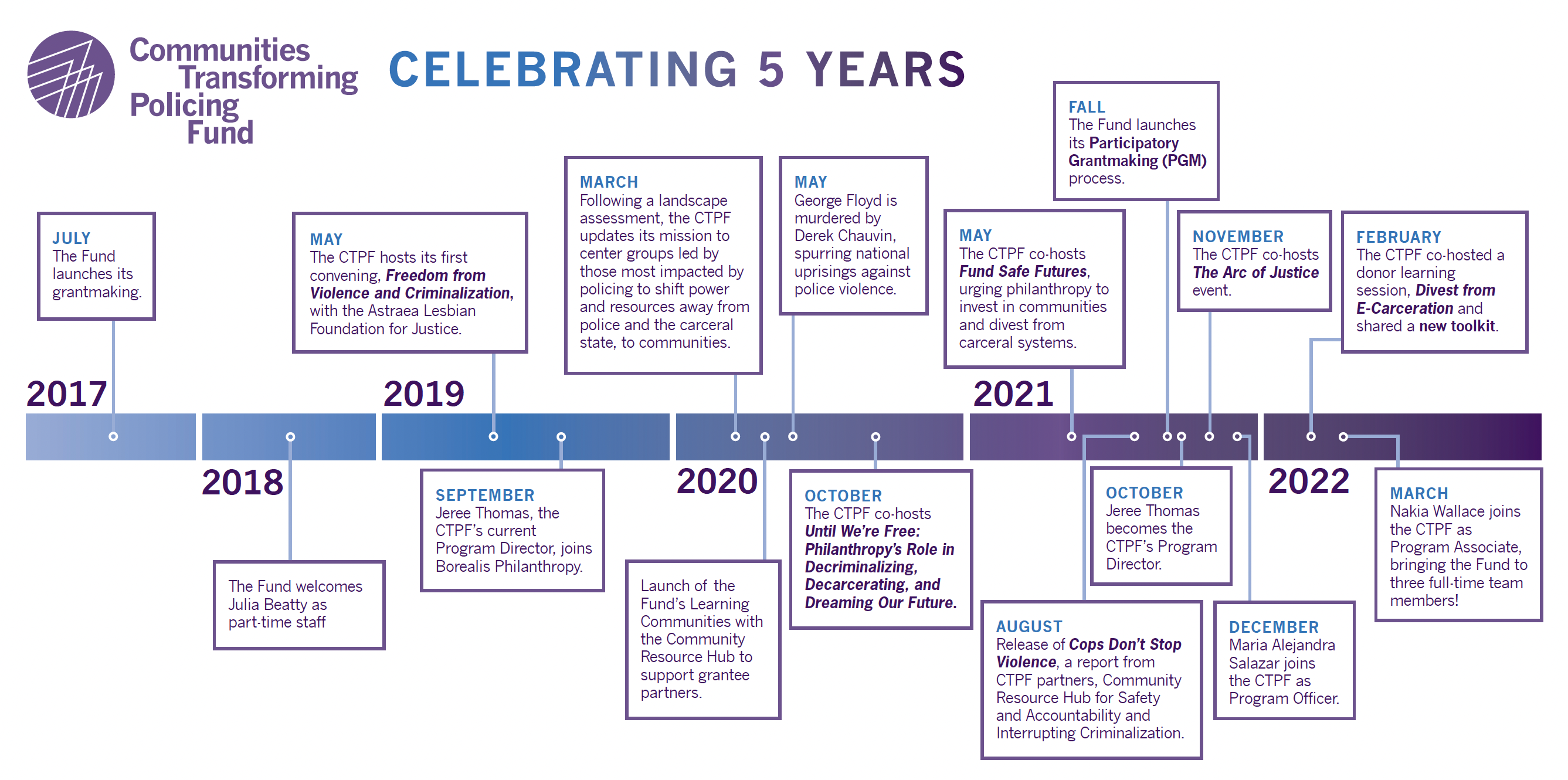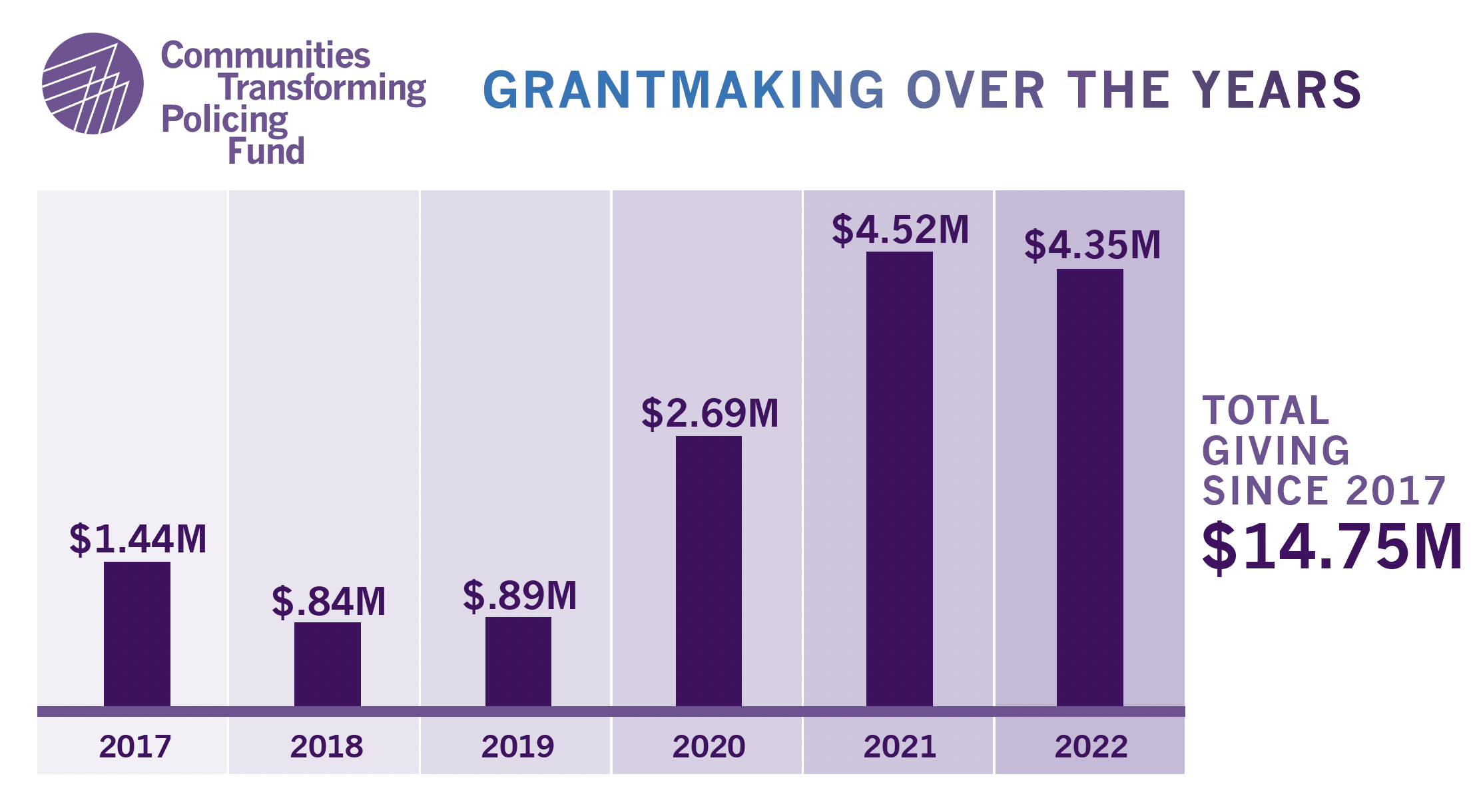*For ASL translation, click here. *Para ver en español, haga clic aquí.
Dear Community,
Last fall, we at the Communities Transforming Policing Fund (CTPF) shared an update with you, our community of grantee partners, applicants, community members, and donors, explaining that we were making a big change by transitioning to a participatory grantmaking process. This change impacts how we make decisions about our core support grants (grants given over multiple years to grantee partners), and specifically WHO makes those decisions. Up until last year, we operated with a traditional model where when grant applicants applied to the Fund, our staff reviewed, assessed, and decided whether a grant applicant was a good match for multi-year funding. This spring we did something different. Instead of making the grantmaking decisions, we developed a space where we could follow the lead of incredible individuals from across the country who have been directly impacted by police violence and the criminal legal system, and that group of people selected CTPF’s 2022 cohort of core grantee partners.

So, why did we make this change? The CTPF team felt called to connect our grantmaking practices to our beliefs around sharing power, challenging hierarchies, and trusting community members. We also believe in the motto of the disability justice movement: “nothing about us, without us.” People have a right to be involved in the decisions that affect their lives. For all of 2021, we studied the concept of ‘participatory grantmaking,’ where funders cede power to communities to make decisions about grants that affect them. Some of our sister funds at Borealis–like the Fund for Trans Generations and the Disability Inclusion Fund–have operated this way since they launched.
Following the lead of community members who have survived carceral violence or have lost loved ones at the hands of the police made sense to us. They not only have a stake in the outcomes of our work – but also a lot of knowledge about what kind of efforts are in most need of funding, who is doing the work, and what makes an impact on the material conditions of their neighbors.
We also acknowledge that losing the decision-making power felt like a risk to us. Would we find committee members who would want to make these decisions? Would the group of people who would make the decisions make the same decisions we would? Did we want them to? We did not know how this would work. To be honest, we had some anxiety about it, especially since it was completely new for the Fund. But weighing it all, we decided to give ‘participatory grantmaking’ a go. And at the one year mark in this process, we want to share five things we’ve learned with you.
1. Trusting our partners allowed us to connect with the people we needed. We didn’t want to make the decisions ourselves about who should be in the group of decision-makers. We asked seven grantee partners, who are deeply immersed in various parts of the movement, to select the committee members themselves. We offered them a description of the role, what the benefits would be to participants, and the honorarium the participants would receive for sharing their time and expertise. We estimated what times of the year we thought people would need to be involved, and for how much time. And then we checked in with them and offered support as they decided who should be a part of the committee. Thanks to our grantee partners, the Chicago Torture Justice Center, Poder in Action, Women on the Rise, Mothers Against Police Brutality, HEARD, HIPS, and the Providence Youth Student Movement (PRYSM), our inaugural participatory grantmaking committee included a tremendously talented team. They were willing to join the process, and to actively shape it based on their lived experience and expertise.
2. Group work takes time to do right; and it’s worth it to invest in the group. We knew we needed to give the committee the right tools and a good amount of time to do the work they needed to do. Decision-making about grant funding requires a lot of work, and it takes time: time to build relationships, to review application materials, to explore the history and work of the applicants, to fill out scoring rubrics, and to meet and decide together. The type of work that CTPF supports is heavy. Discussing work to end police violence when you have lost a loved one to police violence or have experienced police torture could be re-traumatizing. CTPF was incredibly fortunate to partner with the Black Emotional and Mental Health Collective (BEAM) to support our committee. BEAM offered grounding and connection at our meetings and helped us to create a space where we could embrace a full range of emotions in this work. We were able to send care packages to our committee members before their orientation and the deliberation process in addition to an honorarium to recognize their time and expertise.
3. It’s critical to center Disability Justice. In this process we learned the importance of centering disability justice. One of the first offerings from one of our committee members, Topher González Ávila, was to develop accessibility guidelines for the committee. These guidelines included:
- Spotlight – The interpreters and whoever is talking need to be spotlighted for visibility and access purposes.
- Hand raise– Everyone was encouraged to use the hand raise feature on Zoom. This allowed folks to participate fully, without interrupting or overlapping another speaker.
- Presence – Participants were encouraged to state their presence before talking, e.g. “Marsha here”, “Marsha signing/speaking”, “This is Marsha”, etc.
- People-centered spaces – Interpreters participated in each meeting to provide access for everyone involved. We also avoided creating interpreter-centered spaces, e.g. thanking/complimenting interpreters publicly, asking interpreters Deaf-related questions, in order to avoid adding to the power dynamics between Deaf people and their involuntary use of interpreters.
- Language – We encouraged people first language and identity first language when appropriate. For example, person/people who are blind as opposed to referring to a community of people as “the ____”, e.g. “the blind”
- Comfort – We encouraged folks to make themselves comfortable however that looked or felt, by sitting, standing, walking around, laying, drinking water, eating snacks, etc.
- Brave space – We uplifted a general reminder that everyone comes here with good intentions. Sometimes, we say/do things that cause harm to others unintentionally. We are here to call each other in, with love and respect. We are here to grow together.
In this initial round, we fell short in implementing all of the disability justice principles that we’ve learned through this process. For example, while applicants could submit videos instead of written applications, we were not able to ensure that those videos included ASL interpretation or live captioning. While we named having a disability justice lens as a priority in our application, we were not as explicit or transparent as we could be about why dismantling ableism, ableism as defined by Talila A. Lewis, is central to the work we fund and our internal practices. We expected to make mistakes, we did, and we are always learning from them. We will be making changes to our next application process as a result of the learnings from our staff team and the committee.
4. Experimentation and learning are important components of this journey. The stakes felt high for us, and we embraced the risk. We wanted to experiment, while being mindful of potential harm and that we would not get everything “right.” We knew we would make mistakes and there would be opportunities we would overlook. For example, we received very few proposals from Native American-led groups. This was a gap, because we know Native American communities are disproportionately impacted by police violence. In addition, our applicant pool did not include groups in the U.S. territories and also had relatively few groups from the Pacific Northwest. We also learned that while applicants submitted a lot of material, it wasn’t always the right materials for the committee’s review. This is partially because we embraced the trust-based philanthropy principle to limit the paperwork: applicants were welcome to submit reports or application materials that they developed for other foundations. Our hope was that this would relieve the burden on applicants, but it put additional burden on committee members and may have disadvantaged applicants whose previous materials did not speak to CTPF’s criteria. Overall, committee members told us they appreciated and enjoyed the experience. Could it have been better? Yes, we believe it could.
5. As we anticipated, things turned out differently than if we had made the decisions. But we didn’t know how it would be different. The committee did make different decisions than CTPF staff. And indeed, that was a part of the point. The committee prioritized grants going to groups led by individuals directly impacted by police violence. They also prioritized groups with the smallest budget and those doing a combination of work in which they were impacting the material conditions of their neighbors in a tangible way while also advocating for systemic change. As a result, the committee did not select some previous CTPF grantee partners. Not being able to fund any group is difficult, but particularly those who we have supported in the past. We recognize that all of the eligible groups were worthy of funding and that generally it was CTPF’s budget, specifically how much funding we had at the time the committee made decisions, that was the main limiting factor.

This transition has been filled with joy, excitement, challenge, and even anxiety. But this experience has been incredibly rewarding. We continue to take feedback on how we can improve the process. We are happy to share more about this experience with you. Please reach out to the CTPF team at ctpf@borealisphilanthropy.org with any questions.
CTPF Team – Jeree, Maria Alejandra, and Nakia
